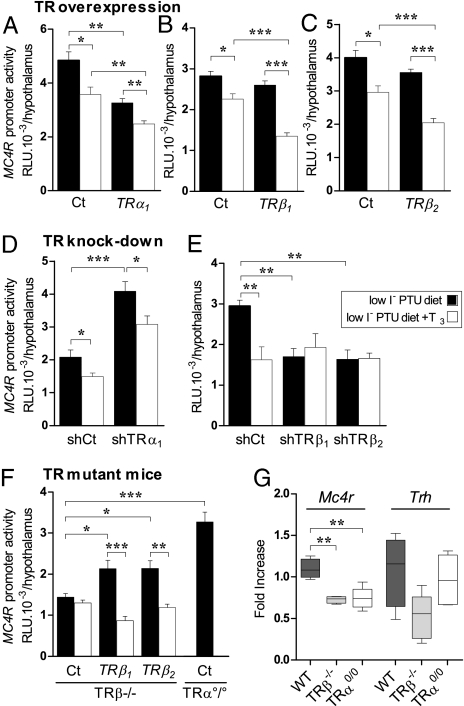Fig. 3.
TRs display isoform-specific roles on Mc4r promoter. (A) TRα1 overexpression diminishes T3-independent Mc4r promoter activity. (B and C) TRβ1 or TRβ2 overexpression reinforces T3-dependent repression of Mc4r-promoter activity. Pups were transfected in the hypothalamic region of the brain with 2 μL of a 250 ng/μL solution of MC4R-f.luc with pSG5-TRα1, pSG5-TRβ1, pSG5-TRβ2, or empty pSG5 vector (25 ng/μL). (D) shTRα1 activates T3-independent MC4R-f.luc expression and abrogates T3-dependent repression. (E) shTRβ1 or shTRβ2 represses T3-independent Mc4r promoter activity and abrogates T3-induced repression. Hypothalamic transfections used MC4R-f.luc (250 ng/μL) and either pCMV-H1-shTRα1, pCMV-H1-shTRβ1, pCMV-H1-shTRβ2, or the empty vector pCMV-H1 (400 ng/pup). (F) TRα°/° and TRβ−/− animals were transfected with MC4R-f.luc with or without TRβ1- or TRβ2-expressing plasmid. T3 treatment, 2.5 μg/g bw. (G) Mc4r and Trh mRNA expression levels in adult TRβ (TRβ−/−) and TRα (TRα°/°) knockout mice. Real-time PCR quantification of Mc4r and Trh mRNA from the PVN of adult male wild-type (WT), TRβ−/−, or TRα°/° mice. Gene expression was normalized with Gapdh. Results are pooled from two independent experiments (n = 7 or 8 per group). One-way ANOVA statistical analysis was performed, followed by Bonferroni's multiple comparisons to assess statistical differences.

